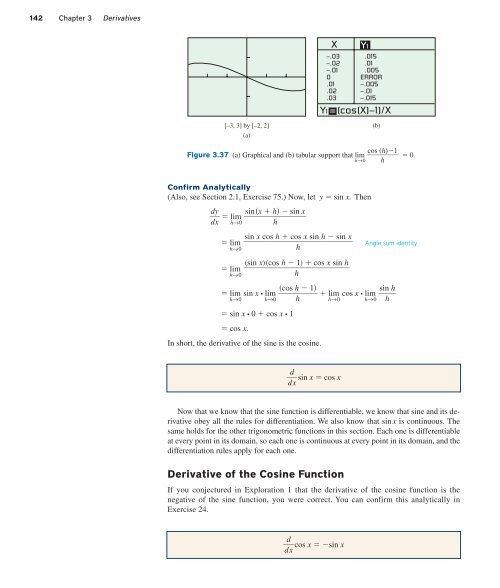5128_Ch03_pp098-184
You also want an ePaper? Increase the reach of your titles
YUMPU automatically turns print PDFs into web optimized ePapers that Google loves.
142 Chapter 3 Derivatives<br />
X<br />
–.03<br />
–.02<br />
–.01<br />
0<br />
.01<br />
.02<br />
.03<br />
Y1<br />
.015<br />
.01<br />
.005<br />
ERROR<br />
–.005<br />
–.01<br />
–.015<br />
Y1 = (cos(X)–1)/X<br />
[–3, 3] by [–2, 2]<br />
(a)<br />
(b)<br />
Figure 3.37 (a) Graphical and (b) tabular support that lim cos ( h)1<br />
0.<br />
h→0 h<br />
Confirm Analytically<br />
(Also, see Section 2.1, Exercise 75.) Now, let y sin x. Then<br />
d y<br />
lim sinx h sin x<br />
<br />
dx<br />
h→0 h<br />
sin x cos h cos x sin h sin x<br />
lim<br />
h→0<br />
h<br />
sin xcos h 1 cos x sin h<br />
lim<br />
h→0<br />
h<br />
Angle sum identity<br />
lim sin x • lim cos h 1<br />
lim cos x • lim sin h<br />
<br />
h→0 h→0 h h→0 h→0 h<br />
sin x • 0 cos x • 1<br />
cos x.<br />
In short, the derivative of the sine is the cosine.<br />
d<br />
sin x cos x<br />
d x<br />
Now that we know that the sine function is differentiable, we know that sine and its derivative<br />
obey all the rules for differentiation. We also know that sin x is continuous. The<br />
same holds for the other trigonometric functions in this section. Each one is differentiable<br />
at every point in its domain, so each one is continuous at every point in its domain, and the<br />
differentiation rules apply for each one.<br />
Derivative of the Cosine Function<br />
If you conjectured in Exploration 1 that the derivative of the cosine function is the<br />
negative of the sine function, you were correct. You can confirm this analytically in<br />
Exercise 24.<br />
d<br />
cos x sin x<br />
d x












